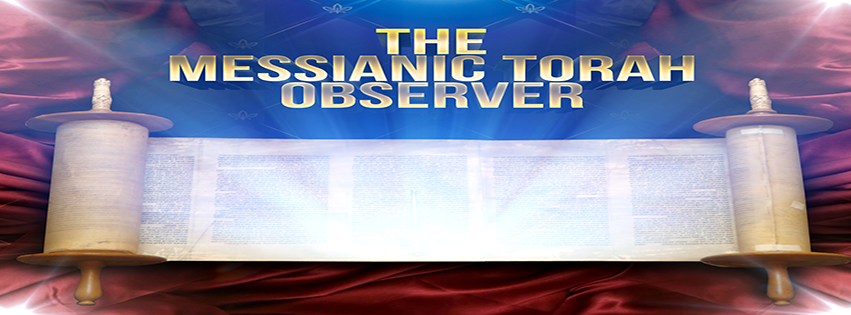Greetings and Introductions
Greetings saints of the Most High. Welcome to another installment of the Messianic Torah Observer. Rod Thomas coming to you on a beautiful Spring midweek day here in the DFW. I want to thank you for taking the time out of your busy schedules to fellowship with me. And as always beloved, it is my hope, trust, and prayer that this installment of TMTO finds you, your families, and your fellowships well and blessed.
As I am publishing this discussion, it is the 19th day of the 12th month on Yah’s sacred calendar year, which translates to March 20, 2025. All indications are that we are very likely going to be celebrating Biblical Rosh Hashanah, Aviv 1, on March 31, 2025, depending on the sighting of the renewed moon the evening before. Barley searchers in the Land have already identified Aviv barley throughout portions of Yisra’el, and other natural players of the observational calendar seem to be firmly in place for Aviv 1 in roughly 10-days’ time. As always, beloved, we will keep you apprised of the latest and greatest findings in the Land as they are made available to us. We post these updates on our website themessianictorahobserver.org.
This is “Unlocking the Keys to the Kingdom Part 2.” I have given this 2nd part of our discussion on the Keys of the Kingdom the subtitle of, “Binding and Loosing on Earth and in Heaven.“
If you have not read or listened to last week’s installment entitled “Unlocking the Keys to the Kingdom: Understanding Yeshua’s Teachings in Light of Torah,” I would humbly encourage you to do so, preferably before you read or listen to this installment. Last week’s installment, Part 1, sets the stage for this week’s teaching.
Our focus passage is Matthew 16:19, which reads:
“I (this is Yeshua speaking to His taught ones) will give you the keys of the kingdom of heaven; and whatever you bind on earth shall have been bound in heaven, and whatever you loose on earth shall have been loosed in heaven” (Legacy Standard Bible (Three Sixteen Publishing, 2022), Mt 16:19).
The apostles were given “wide berth” (i.e. great latitude) in terms of authority over the Way — the True Faith once delivered — by their Master, Yahoshua Messiah. It goes beyond the Master simply passing on to them the keys of the Kingdom of the Heavens as stated in the first portion of verse 19. Recall from our discussions in part 1 of this series that we came to an understanding that the keys of the Kingdom that Yahoshua was promising to give to His taught ones had to do with granting them the authority to teach, create or invoke, and expound upon halachah for His ekklesia/Kehila. And in case it’s not clear what is meant by the term “halachah,” particularly in this context, we’re talking about the course or pathway a disciple of Yeshua Messiah is required to walk in order to be deemed righteous; how the disciple is to conduct themselves in their day-to-day lives that puts them in sync with the will and purpose of Yehovah. It is this halachah that opens the Gates of the Kingdom of Heaven to Yah’s chosen ones. Those who choose to not walk out the halachah of the Apostles will find the Gates of the Kingdom of Heaven locked and inaccessible to them.
Yeshua’s conferring of authority to His disciples by granting them the keys of the Kingdom would be carry little to no weight or significance if the apostles did not have the wherewithal to use or employ those keys. And so, Yeshua made His disciples’ authority iron-clad (i.e. such that their authority could not be disputed either on earth or in heaven) by declaring, “whatever you bind on earth shall have been bound in heaven, and whatever you loose on earth shall have been loosed in heaven.” Their authority would extend from local assemblies/congregations, such as described in Matthew 18:18, to the entire Body of Messiah.
Now, we must face the question of whether leaders in the Messianic Faith today possess the authority to invoke or create halachah to the same extent that Yeshua’s chosen and anointed sent ones—Yeshua’s apostles — possessed? And the answer to this important question is: Not exactly, but sort of. Modern-day Messianic/Netsari leaders possess the authority to enact or implement and expound upon the halachah of the original Apostles over their assigned assemblies. For them to invoke or create halachah that is not found in the apostolic scriptures by modern day Messianic leaders would place them in the office of an Apostle, which I do not believe we have any members of the Body operating in today. Now, that’s just me saying this. This is my opinion. And I know that this statement will probably offend some out there who believe they possess the office of Apostle here in 2025. But from what we know about ecclesiastical history beloved, John (Yochanan) the Revelator was the last apostle to die. Biblically speaking, an apostle is defined as an individual who is sent on a mission by the Master Yeshua. They are emissaries of Yahoshua Messiah. And there were specific criteria or qualifiers for being an apostle to include being directly appointed to the office by Yeshua Himself; being an eyewitness of the Master’s resurrection; and being a witness to the Master’s earthly ministry (Act 1:21-26). Now, one could argue that Paul did not exactly possess these criteria, and I would agree with that argument to some extent. Scripture does not give us any indication that Paul was a witness to the Master’s earthly ministry or that he was an eyewitness to the Master’s resurrection. And this no doubt put him at variance with his apostolic colleagues throughout much of his career as the apostle to the Gentiles. But what we do know is that Paul was directly appointed to the office of an apostle by the Master (Act 9:10-22). There is no doubt about that. And if Yeshua certified Paul as His apostle, then he possessed the same authority the Master spoke of here in Matthew 16:19.
But I say no to there being any apostles beyond 90 AD.
Defining “Biding” and “Loosing”
The Greek term used for “binding” is “deo” and the Greek term used for “loosing” is “luo”.
The use of these terms “deo” and “luo” in a few other New Testament passages may help us better understand what Yeshua meant when He used them in verse 19 of Matthew chapter 16:
In Luke 13:10-17, we have the story of Yahoshua healing or freeing or exorcising a demon-possessed or demon-bound woman on the Shabbat. An offended synagogue ruler challenged Yeshua’s freeing of this bound woman, declaring to a listening crowd that there are six days in a week in which an individual may be healed, but not on the Sabbath. But the Master pushed back on the synagogue ruler’s misunderstanding of the freeing purpose of the Shabbat:
15 But the Lord answered and said to him, “Hypocrites! Does not each one of you untie his ox or his donkey from the feeding trough on the Sabbath and lead it away to water it? 16 And this woman, who is a daughter of Abraham, whom Satan bound (i.e. deo) ⌊eighteen⌋ long years—is it not necessary that she be released (i.e. luo) from this bond on the day of the Sabbath?” (W. Hall Harris III et al., eds., The Lexham English Bible (Bellingham, WA: Lexham Press, 2012), Lk 13:15–16.)
We find in John 11:38-44 the story of Yahoshua’s resurrecting of his beloved friend Lazarus. The concept of loosing and binding is concentrated in Yeshua’s instructions to witnesses to the resurrection that they attend to the resurrected Lazarus, whose feet and hands were bound (i.e. deo) by strips of cloth, by releasing (i.e. luo) him from those cloths or bindings.
And last, in John 20:19-23, we find the story of Yeshua appearing to His taught ones within a short time after His resurrection. In his interaction with His disciples, Yeshua breathes upon each of them and imparts unto them the Holy Spirit. And then He grants them authority to forgive (like loosing) the sins of others as well as not forgive (like binding) the sins of others. Although the terms deo and luo were not used in the Greek manuscripts for this passage, we can recognize the concept of having loosing and binding authority.
It should be understood that the concepts of binding and loosing are not exclusive to Yeshua’s teachings and declarations. The binding and loosing concepts were part of Jewish or Rabbinic halachic literature.
We find in the Mishnah, tractate Peah, chapter 5, Mishnah 6 the following example:
“He who sells a field — the seller is permitted (i.e. “mutar,” or “loosed”) [to collect produce designated for the poor from that field, since he no longer owns the field] but the buyer is forbidden (i.e. “‘asur” or “bound”) [to collect this produce].“
The Hebrew terms “‘asur” and “mutar” (in the hifil) as recorded in Rabbinic literature denote the prohibition (i.e. the binding) and the permitting (i.e. the loosing) of a thing within the confines of the Jewish religion. Again, it’s all about the halachah.
When we factor these pieces into our attempt to gain the best understanding of what Master Yeshua was authorizing His taught ones to do in terms of His ekklesia/Kehila, we arrive at a few explanations:
- The taught ones would have authority over all demonic activity (e.g. Luk 10:17-19; 13:16). Thus, they would be authorized to perform exorcisms. This, of course, features prominently in the Catholic Church where the popes are descended from Peter are vicars of Christ. Thus, these possess the authority to exorcize demons in the world. To free those bound by demons.
- Peter determines who makes it into heaven and who doesn’t. Again, the ones who makes it into heaven are loosed or permitted, while those denied entry into heaven are bound. This is certainly a Roman Catholic Church concept of the authority of the so-called Vicar of Christ.
- Peter would be granted the authority to forgive (i.e. loose) or not forgive sins (i.e. bind). This also runs in sync with the Vicar of Christ heresy. The concept of an apostle forgiving sins or not runs contrary to the Judaistic understanding and acceptance that only Yehovah/God forgives sin (Mar 2:7; Luk 5.21). As we saw in John 20:23, Yeshua granted his apostles the authority to forgive sins or not, as He had been granted the same authority to forgive sins or not from His Father. Many will disagree with this, but the scriptures say what the scriptures say. And we know Yeshua declared the following:
“… Verily I say unto you, that ye which have followed me, in the regeneration when the Son of man shall sit in the throne of his glory, ye also shall sit upon twelve thrones, judging the twelve tribes of Israel.” (The Holy Bible: King James Version, Electronic Edition of the 1900 Authorized Version. (Bellingham, WA: Logos Research Systems, Inc., 2009), Mt 19:28–Lk 22:30.)
But in terms of popes of the Catholic Church, or any denominationalist church leaders who claim apostolic authority, no others have been granted the authority to forgive or not forgive sins.
- Peter has the sole authority to interpret scripture. Yet another Roman Catholic concept focused on the authority the popes took onto themselves. Indeed, truly Spirit-filled Messianic or Netsari leaders have the authority to interpret scripture as the Spirit so provides them the means to do so.
- The Talmudim turned Schlichim (i.e. Apostles) would possess the authority to render halachah for the ekklesia/Kehila of Mashiyach. Matthew 18:11 and 28:18-20 serve as excellent support passages for this explanation. Thus, this appears to be the soundest, contextually based explanation of the Master’s declaration of “loosing” and “binding” authority for His taught ones. The focus is on establishing halachah for the Kehila/ekklesia that would open the Malchut haShamayim to Jew and Gentile alike. The other four are not contextually valid explanations for Yeshua’s use of the concept of “loosing” and “binding” in Matthew 16:19.
How Does the Apostle’s Loosing and Binding Authority Here on Earth Affect Heaven?
Yahoshua declared to His taught ones that whatever they bind on earth “shall have been bound in heaven and whatever they loosed on earth shall have been loosed in heaven” (Mat 16:19; NASB).
Notice we have a past-tense situation at work in this verse whereby a present action on earth by the apostles would have already had a positive, established impact in heaven. For us 21st century westerners, this makes no sense. How can some present action by an apostle here on earth already have a positive impact in heaven?
Of this past-tense situation, Ernest DeWitt Burton writes:
“If [the perfect tense] implies a past action and affirms an existing result” (Syntax of the Moods and Tenses in New Testament Greek (T&T Clark, 1898), p. 37).
In other words, “whatever you (My disciples soon to be Apostles) bind on earth will already have been bound in heaven, and whatever you loose on earth will already have been loosed in heaven” (Hegg, T., Matthew Commentary, p. 676).
It’s still not making sense, right? How can the actions of mere mortals on this earthly plain impact events/situations in heaven? Ah! Here’s the sauce, beloved, that brings this delicious spiritual meal to its fullest potential:
In making this binding and loosing declaration to His taught ones in relation to them also receiving the keys of the Kingdom of the heavens, the Master publicly recognized that His taught ones would act in positions of authority under the expressed direction and guidance of the Holy Spirit. Yehovah’s Indwelling Presence.
Let’s go back to John 20:
(21) Then said Yahoshua to them (His disciples) again, Shalom Aleichem. As My Abba has sent Me, even so I send you. (22) And when He had said this, He breathed on them and said to them, “Receive the Ruach Kodesh. (23) If you forgive the sins of any, they are forgiven. If you withhold forgiveness of a man’s sins, they are kept.” (RSTNE).
Now, stepping back and looking at this thing full-on, we find Yahoshua’s loosing and binding declaration on both earth and in heaven would be nothing short of Yehovah carrying out His will and purpose here on earth through Yeshua’s apostles. And because these taught ones belonged to Yahoshua, they were 100% approved by Yehovah. And this being the case, whatever they did on earth in the capacity of the authority granted unto them by Yeshua was equivalent to Yehovah already having established or approved of those things they did on earth, in heaven. What they would do as Yeshua’s apostles was already preordained and approved of in heaven because they were direct agents of Yehovah, operating exclusively by His Set Apart Spirit.
Binding and Loosing Enshrined in the Apostolic Writings
This binding and loosing authority and the keys of the Kingdom then are enshrined in the Apostolic writings (i.e. the New Testament or the Brit haDashah). The apostolic writings serve as the roadmap or layout for the Master’s Kehila/ekklesia.
The Apostle Shaul/Paul clearly understood the weight of this office in relation to the reality of the Master’s Kehila/ekklesia:
(19) Consequently; therefore, you (i.e. Ephesian Gentiles) are no longer strangers and foreigners, but you are fellow citizens with the saints and members of the household of God (i.e. the commonwealth of Yisra’el); (20) built on the foundation of the apostles and prophets; Yahoshua Messiah Himself being the cornerstone (21) in Whom the whole building, joined together, grows into a holy temple in Yehovah, (22) in Whom you also are built up together into a dwelling place of Ahlohim in the Spirit (Eph 2; LEB modified).
Now, this flies in opposition to most messianic thinking, especially as it relates to matters of authority in our own Faith community today. Many believe authority over the Messianic Community should rest on some form of Rabbinic leadership (i.e. Messianic Rabbis and such). But Yahoshua in no way placed authority of His Kehila/ekklesia into the hands of the Rabbis and Scribes. This being the case, according to Yeshua and to Paul, why are so many of us coming under the covering, so to speak, of Messianic Jewish Rabbis today? Why aren’t we all under the headship of Yeshua and His anointed, appointed Apostles and the Spirit-filled leaders of our local groups and assemblies?
Are There Apostles in the True Biblical Sense of the Title Apostle Today?
Are there then apostles in the true biblical sense of the title apostle alive and functioning today? I personally do not believe so. If what scripture says about the authority that Yeshua gave to His disciples turned apostles is to be believed (and I believe it absolutely is to be believed) and followed, then these would be apostles today would still be writing scripture, crafting halachah; and doing everything that the apostles of the first century did. That would mean that the Kehila/ekklesia would still be in the process of being built upon them even today. I believe, as I previously stated, that the last true apostle was Yochanan (John) the Revelator who died sometime around 90 CE.
Beyond the Yeshua-selected apostles of the first century, Yeshua gave His ekklesia/Kehila: (1) Prophets; (2) Evangelists; (3) Pastors; and (4) Teachers. Yahoshua gave these anointed offices of the Body of Mashiyach, none of which are Rabbis, mind you, as we have but One Rabbi (listen to my teaching on Call No One Rabbi). But the Master gave us these powerful offices for the equipping of the saints; for the work of the ministry; for the building up of the Body of Mashiyach until we all reach the unity of the faith and the knowledge of the Son of Yehovah; to a mature man; to a measure of the maturity of the fullness of Mashiyach so that we may no longer be infants, tossed about by waves and carried about by every wind of teaching, by trickery of people, by craftiness with reference to the scheming of deceit (Eph 4:11-14; LEB).
Some have referred to this as the 5-fold ministry of the Church. Okay. Whatever. But the keys of the Kingdom and the authority over the halachah of the Master’s Kehila/ekklesia rest exclusively with the Apostles. Thus, the way we are to walk out his Faith was specifically given over to the apostles — Yeshua’s sent ones — for dissemination, development, application, and so forth. This job would have gone to the Rabbis, but Yeshua took that opportunity away from them. Yeshua equipped His taught ones turned sent ones with the Holy Spirit — the Ruach haKodesh — that ordered and guarded their governing and building work.
Back to these Keys of the Kingdom of the Heavens: These were the authority to implement, properly interpret, and administer the Master’s teachings to all humanity. And this being the case, the gates of the Kingdom of Yehovah would be opened to all, including non-Jews which the Pharisees denied access, who would seek to come into a covenant relationship with the Ahloha/God of Avraham, Yitschaq, and Ya’achov, and receive and enter Yehovah’s glorious Kingdom. This would be the ultimate fulfillment of Yah’s covenant promise to Avraham:
“And in thy seed shall all the nations of the earth be blessed…,” (Gen 22:18; 26:4; KJV).
And while they built the Body — the Kehila — in the first century, the apostles not only drafted/wrote out the framework for the ekklesia, they personally exercised or put into action the authority Master Yeshua gave them. Probably the greatest example of them exercising their given authority is seen in the account of the Jerusalem Council (Act 15). Another example of them exercising their authority involved the undeniably clear halachic instructions put forth from Paul/Shaul to the assemblies he oversaw, which are recorded in his dozen or so writings. And then there are the pastoral epistles that were designed to instill and maintain righteousness, peace, and love throughout the Body of Mashiyach. The apostles’ actions and teachings were expositions, expansions, explanations if you will, of the teachings and example of Yeshua Messiah, who Himself taught and modeled His Father’s Torah to His taught ones.
Tim Hegg sums this whole apostolic authority as follows:
“Ultimately, however, the authoritative voice of the Apostles was vouched safe in the inspired Scriptures, which when completed, formed the constitution (as it were) by which the ekklesia of Yeshua would be governed” (The Gospel of Matthew Commentary, Torah Resource, 1995; p. 677).
In Conclusion
So, let’s see if we can bring this whole question of what the Keys of the Kingdom of the Heavens are all about, and how they relate to Torah-Commandment-keeping.
The Keys of the Kingdom are the halachah of our Faith Community. These keys open the gates to the Kingdom of the Heavens for us because they reveal the ways we are supposed to conduct our lives as future Kingdom dwellers. Prior to Yeshua and the Apostles, the gates to the Kingdom were locked to all but a remnant of souls, because the Jewish religious leaders imposed their own manmade halachah, which Yeshua said nullifies Torah (Mat 15:6).
Yeshua took the keys to the Kingdom away from the Jewish religious leadership and gave it to His taught ones, soon to be sent ones or Apostles. Possession of the keys to the Kingdom meant they had the authority to exposit, formulate, explain, and apply halachah — the way Yeshua’s chosen ones are to conduct their lives — for Yeshua’s Kehila/ekklesia. The apostles were given a significant amount of latitude in their handling of these keys: What they permitted members of the Body to do, it would have already been established in heaven. And whatever they prohibited members of the Body of Mashiyach from doing would have already been established/approved in heaven. It would all have been recorded in the Court of Heaven.
The halachah that the Apostles provided to the ekklesia/Kehila would be entirely based upon the teachings and example of their Master Yahoshua Messiah. The teachings and example of Yeshua Messiah were the fullest potential of the Creator’s Torah possible. Yeshua Himself said that He did not come to eliminate His Father’s Torah, but rather, He came to take His Father’s Torah to its fullest and greatest potential that was to be walked out in the lives of His followers. The Apostles, having the Keys of the Kingdom, would take the Master’s teachings and His example, and with the leading and guidance of the Holy Spirit, create and explain and interpret and apply those things to the Kehila/ekklesia of Yeshua HaMashiyach.




